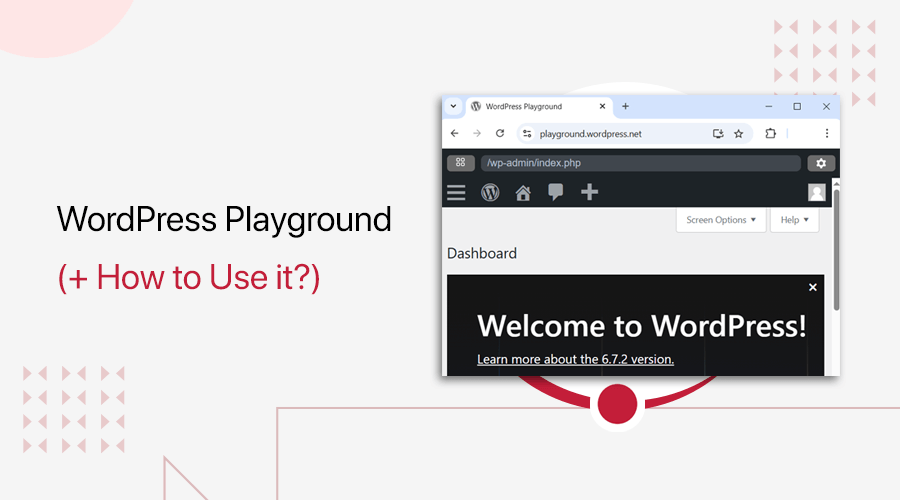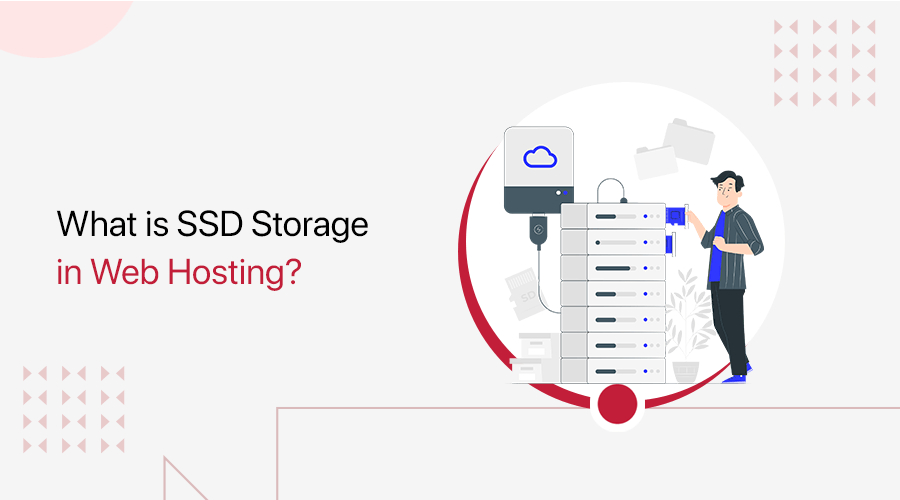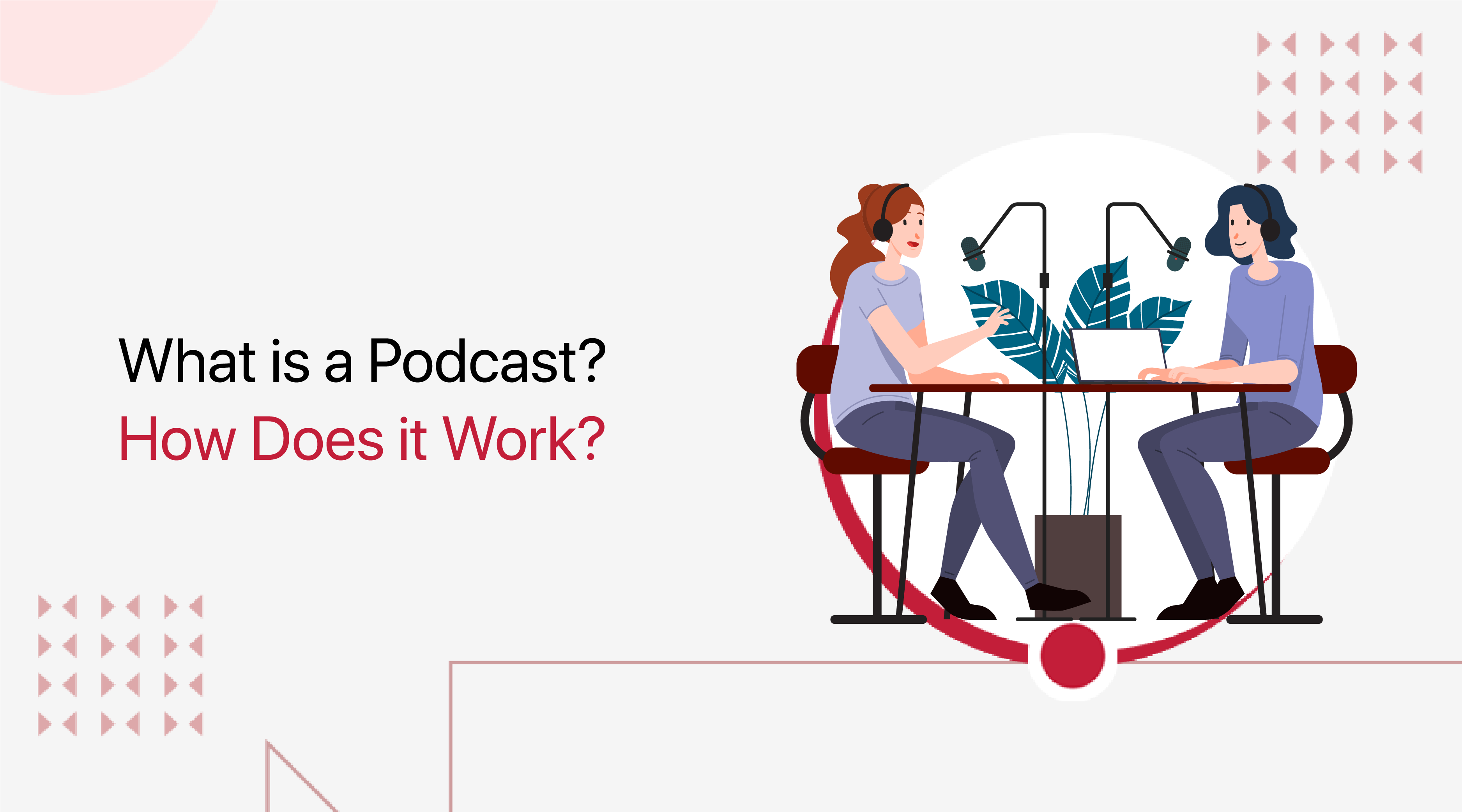
What is a podcast? Are you confused and looking for a way to start your podcast? If yes, then you’ve come to the right place.
In today’s digital age, podcasting has become a powerful medium that captivates audiences. You might have come across the term “podcast” in conversations or online discussions.
Besides, a podcast is an audio-based medium that allows you to share engaging content on a wide range of topics. Imagine tuning in to your favorite radio show but with the added convenience and flexibility of accessing it anytime, anywhere.
But if you’re still wondering what podcast does and how it works, then we’ve come up with this article. Here, we’ll explain what podcast means and how it works. Further, we’ve also included how to create podcasts using powerful podcasting platforms.
So, let’s dig in!
What is a Podcast? – A Brief Introduction
A podcast is an audio-based medium where individuals or groups create episodic content on various topics. Unlike traditional radio shows, they are typically pre-recorded and made available for on-demand listening. It offers the flexibility to tune in whenever and wherever you prefer.
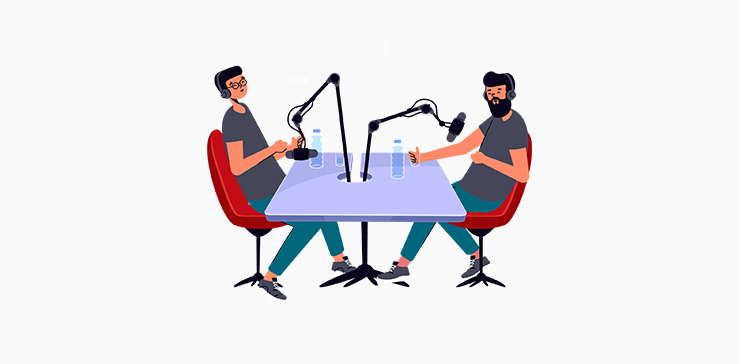
Further, podcasts are often hosted on dedicated platforms like Apple Podcasts, Spotify, or Google Podcasts. So you can subscribe to your favorite shows and receive automatic updates about new episodes.
Besides, the beauty of podcasts lies in their diverse range of topics and formats. You can tune into crime mysteries, educational discussions, captivating storytelling, or even comedic banter.
Hence, podcasts enable you to delve into your interests and explore new ideas. As well as you can learn from experts while being entertained.
With that, let’s take a look at the benefits of podcasting.
Benefits and Advancements in Podcasting
Whether new or beginner, exploring podcasting’s benefits helps you grasp its full potential. So, let’s take a closer look at the compelling advantages that podcasting brings to the table.
- Variety of Topics: Podcasts cover various subjects, catering to diverse interests. Whether you’re into history, science, self-improvement, or pop culture, there’s a podcast for you.
- In-depth Exploration: Podcasts offer in-depth discussions and explorations of topics. It provides a platform for experts, enthusiasts, and thought leaders to share valuable insights.
- On-Demand Listening: Unlike live radio shows, podcasts are pre-recorded and available for on-demand listening. You can choose which episodes to listen to and skip around as per your preference.
- Entertainment: Whether you’re into storytelling, comedy, or fictional narratives, podcasts transport you to different worlds and offer a break from reality.
- Personal Growth: Podcasts offer educational content that helps you expand your knowledge. You can learn new skills, and gain insights into various subjects.
- Cost-Effective: Most podcasts are available for free, requiring only an internet connection and a compatible device. Making it a cost-effective form of entertainment and information.
- Motivational: Many podcasts feature inspiring stories and interviews with successful individuals. Hence, it can fuel your ambition and provide encouragement.
- Connections: Lastly, podcast hosts often build authentic connections with their audience, creating a sense of intimacy and trust. This enhances your listening experience and makes you feel part of a community.
Therefore, podcasting offers a rich and diverse audio landscape that caters to various interests. Also fosters learning and personal growth, providing entertainment and connection in a convenient manner.
Genre Spotlight: Exploring the Podcast Categories
So, we’ve covered the benefits of podcasting, now let’s explore types of podcasts.
1. Audio Podcast
Audio podcasts are a captivating medium that immerses you in a purely auditory experience. You can create a unique opportunity to engage your imagination through storytelling, informative discussions, or monologues. And captivate listeners by painting vivid mental and emotional images.

Furthermore, audio podcasts offer a flexible listening experience. You can also enjoy them wherever you go, whether you’re commuting, exercising, or simply relaxing at home. Simply using smartphones and portable media players, you have the freedom to delve into various topics.
The beauty of audio podcasts lies in their accessibility and the intimacy they foster. As a listener, you can connect with the voices behind the microphone, forming a personal and authentic bond. Besides, it allows you to dive into the stories, insights, and perspectives of hosts and guests.
So, give audio podcasts a try, and embark on a journey that will enrich your mind and ignite your imagination.
2. Video Podcast
Video podcasts, also known as vodcasts or videocasts, bring a visual dimension to the podcasting experience. Incorporating video footage alongside the audio content provides an additional layer of engagement and a more immersive viewing experience.

Besides, its visual aspect allows for more dynamic and varied content. It opens up opportunities for showcasing demonstrations, interviews, presentations, or behind-the-scenes footage. You can get live reactions, visual aids, and captivating visuals that complement the audio narrative.
Furthermore, it provides a sense of connection and familiarity. Seeing the faces and body language of the hosts and guests adds a personal touch. Making you feel like you’re part of the conversation.
Besides, with the rise of platforms like YouTube and Vimeo, video podcasts have gained popularity and reach a broader audience. They offer a blend of audio storytelling and visual engagement, catering to different preferences.
Now, dive into the world of video podcasts and unlock a new dimension of engaging.
3. Live Podcast
Live podcasts offer a unique and interactive experience where listeners can be part of the action in real-time. Unlike pre-recorded episodes, live podcasts are recorded in front of a live audience. This brings a sense of immediacy and spontaneity to the podcasting world.
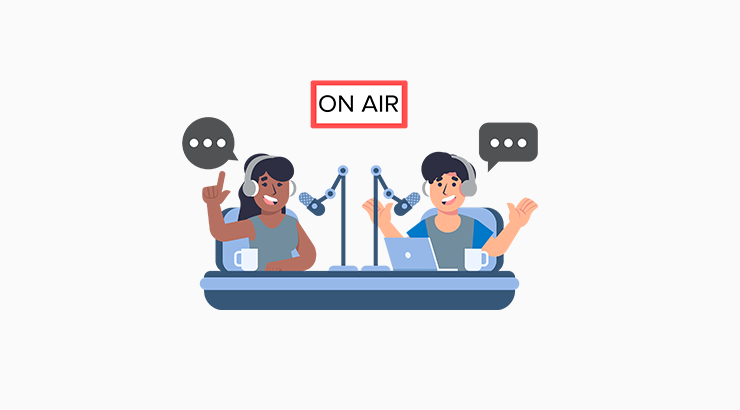
Additionally, attending a live podcast event allows you to witness the recording process firsthand. You can see the hosts and guests in action, observe their interactions, and experience the chemistry that unfolds on stage.
Besides, the live setting often includes opportunities for audience participation. For example, Q&A sessions, live polls, or even on-the-spot interactions.
There are some benefits of live podcasting, let’s look at them.
- By attending live events, you have the chance to connect with fellow fans, like-minded individuals, and even the podcast creators themselves.
- These events create a shared space where enthusiasts can come together, share their passion, and engage in discussions surrounding the podcast’s topics.
- Live podcasts also offer exclusive content and experiences that may not be available in regular episodes.
- Hosts may unveil surprises, conduct live interviews with special guests, or provide behind-the-scenes insights into the podcast’s production.
- Attending a live podcast event can give you access to unique and memorable moments that enhance your connection with the podcast and its community.
So, if you’re looking for an immersive and interactive podcasting experience, then consider exploring live podcasts.
Podcasting Mechanics: Recording to Distribution
Podcasting is a method of distributing audio content over the internet, allowing you to listen to your favorite shows whenever and wherever you want.
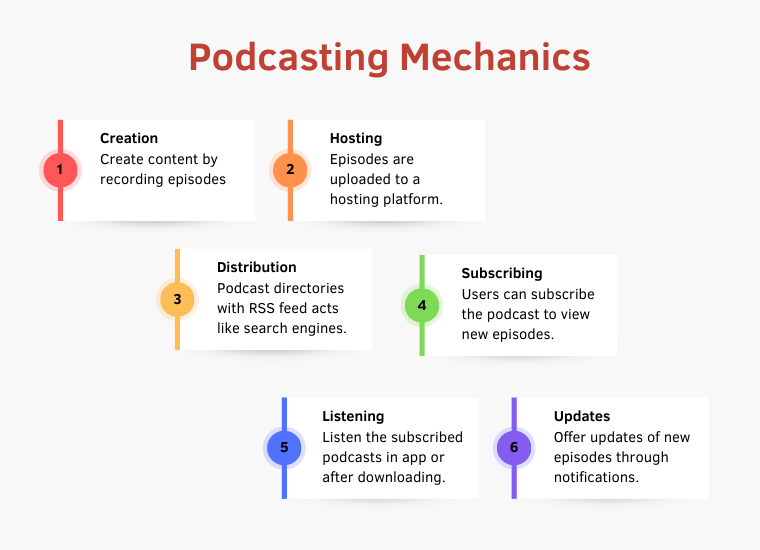
i) Creation: First, podcasters create their content by recording episodes on topics they’re passionate about. They use professional recording equipment and software to ensure high-quality audio. Also, the episodes are typically edited to remove any mistakes or unwanted portions.
ii) Hosting: Once the episodes are ready, podcasters upload them to a podcast hosting platform. This platform acts as a storage space for the audio files, ensuring they are accessible to listeners. It also generates an RSS feed, a special file that contains info about the podcast and its episodes.
iii) Distribution: The RSS feed is the key to podcast distribution. It allows podcast directories and apps, like Apple Podcasts, Spotify, or Google Podcasts, to display the episodes. These directories act as search engines for podcasts, making it easy for listeners.
iv) Subscribing: When you find a podcast you enjoy, you can subscribe to it. So, you’ll automatically receive new episodes as they release. This way, you don’t have to manually search for new episodes or remember when they come out.
v) Listening: Once you subscribe, you can listen to episodes using a podcast app on your smartphone, tablet, or computer. The app also allows you to browse through your subscribed podcasts, download episodes, and play them whenever you want.
vi) Updates: Podcast episodes are typically released on a regular schedule, whether it’s daily, weekly, or at other intervals. As a listener, you’ll receive notifications or see new episodes in your app’s library whenever a new one is available. This way, you can stay up to date with your favorite shows.
So, that’s how podcasting works!
Podcasting 101: Launching Your Show
First and foremost, it’s important to define your podcast’s concept and target audience. Consider the topics you’re passionate about, your expertise or unique perspective, and the audience you want to reach. This will help to shape the direction and focus of your podcast.
Now, let’s take a look at things you need to take care of while creating a podcast.
1. Podcasting Equipment and Software
Podcasting equipment and software play a crucial role in producing high-quality audio for your podcast.
To get started, you’ll need a few key items.
i) Microphones
First, a reliable microphone is essential to capture clear and professional-sounding audio. USB microphones are a popular choice for beginners due to their ease of use and affordability.
Additionally, a pair of comfortable headphones will help you monitor audio levels and ensure optimal sound quality during recording and editing.
ii) Pop-filter
Further, you may consider investing in a pop filter or a microphone stand to enhance audio quality and maintain consistency. Pop filters reduce plosive sounds (such as “p” and “b” sounds) that can cause distortion. While a microphone stand keeps your microphone stable and at an appropriate distance.
iii) Podcasting Software/Digital Audio Workstation (DAW)
Popular software options include Audacity (a free and user-friendly DAW), Adobe Audition, GarageBand (for Mac users), and Reaper. It also offers features like multi-track editing, noise reduction, and audio effects. Hence, this fine-tunes your recordings and creates a polished final product.
Besides equipment and software options, consider your budget, technical proficiency, and long-term podcasting goals. Also, remember, the content and storytelling are ultimately what engage and captivate your audience.
Therefore, with the right tools in hand, bring your podcasting ideas to life and deliver an exceptional podcasting experience.
2. Planning Your Podcast
Planning your podcast is an essential foundation for success. It involves defining the purpose, format, and target audience of your show.
- Begin by identifying the topic or theme that you’re passionate and knowledgeable about.
- Next, consider the format of your podcast like a solo monologue, or a panel discussion.
- Think about the flow of your episodes, the ideal episode length, and the frequency of your releases.
- Furthermore, determine who your podcast is aimed at and what value you want to provide them.
- Also, you need to research your audience’s interests, preferences to tailor your content and make it relevant to their needs.
- Create a content calendar or episode outline. This helps you stay organized and ensures a steady stream of engaging episodes.
- Lastly, decide on a podcast name that reflects your show’s identity and resonates with your target audience.
Don’t forget to explore various marketing strategies like social media promotion, collaborations, or guest appearances on other podcasts.
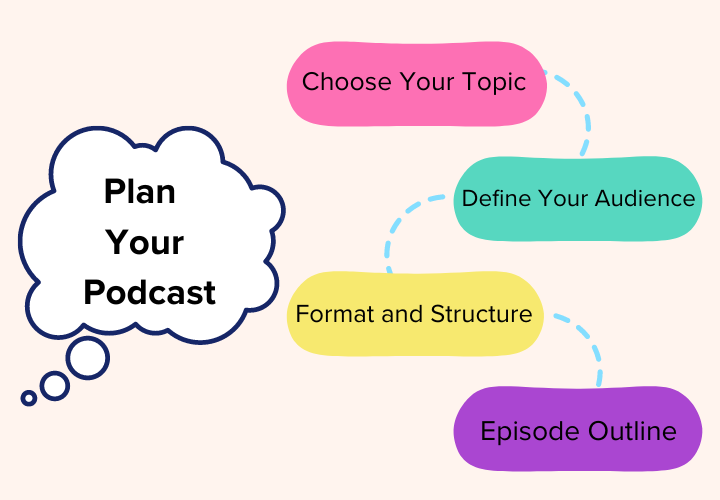
So, invest time in the planning phase to lay a strong foundation for your podcasting journey.
3. Recording a Podcast
Recording your podcast is the exciting step where you bring your ideas to life and capture your episodes. Firstly, find a quiet location with minimal background noise to ensure clear audio. Consider using soundproofing techniques or recording in a room with carpets and curtains to minimize echoes.
Before you start recording, ensure your microphone, headphones, and recording software are all set up correctly. Perform a quick test recording to check audio levels, clarity, and any potential technical issues.
Furthermore, depending on your podcast’s format, you may have a script or an outline to guide your episode. Having a structure in place helps you stay focused and organized during the recording process.
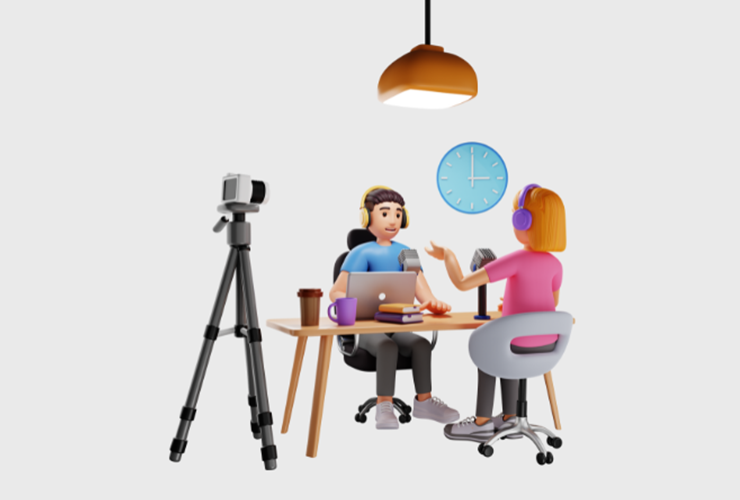
To ensure a smooth recording process, here are some key steps to follow:
- Do a vocal warm-up to loosen up your voice and reduce any nervousness.
- Take a moment to relax, breathe deeply, and get into the right mindset for recording.
- When recording, speak clearly and with confidence and maintain a consistent distance from the microphone.
- Also, avoid excessive background noises like tapping on the table or shuffling papers.
- Keep an eye on your audio levels throughout the recording to ensure they are neither too low nor too high.
- Adjust the microphone input or gain settings if needed, and periodically check for any audio distortions or clipping.
- Don’t be afraid to redo sections or retake certain parts of your recording if necessary.
Remember, recording your podcast is an iterative process, and it’s common to make improvements along the way. Don’t strive for perfection right from the start. With practice and experience, you’ll become more comfortable and confident in your recording skills.
So, embrace the recording process and have fun.
4. Editing Podcast
Editing your podcast is a crucial step that adds polish and professionalism to your episodes. It involves refining the audio, removing mistakes or distractions, and ensuring a seamless listening experience for your audience.
Here are some essential steps to follow when editing your podcast:
- Start by listening to your entire recording from start to finish.
- Identify areas with background noises, long pauses, or segments that may need to be re-recorded.
- Use editing software to trim out any dead air, long pauses, or repetitive content.
- Ensure smooth transitions between different segments or topics in your episode.
- Try adjusting volume levels, equalizing the audio, and reducing background noise or hiss.
- Consider using noise reduction plugins or tools to eliminate any unwanted distractions.
- Also, pay attention to the clarity of your speech and eliminate any stumbles, mispronunciations, or verbal tics.
Once you’ve made all the necessary edits, listen to the entire episode multiple times and ensure a smooth and balanced audio mix. Also, adjust volume levels as needed, ensuring that all voices and sounds are clear and balanced throughout.
If you’re satisfied with the edits, then export your episode in the desired audio format. Furthermore, keep a backup of the edited files for future reference or re-editing if needed.
5. Publishing Podcast
Publishing your podcast is the exciting step where you share your episodes with the world. Here’s what you need to know about the process:
- First, choose a podcast hosting platform like Apple Podcasts, Spotify, and Google Podcasts.
- Then, compare their features, pricing, and ease of use to find the one that suits your needs.
- Next, ensure that your audio files are properly edited and saved in the recommended format (usually MP3).
- Create episode descriptions that accurately reflect the content and engage potential listeners.
- Plus, you need to consider adding relevant keywords and tags to improve discoverability,
- Once your episode is ready, upload it to your chosen hosting platform.
- Further, provide the necessary metadata, like episode title, description, and artwork.
- Finally, set the release date and schedule your episodes for publication.
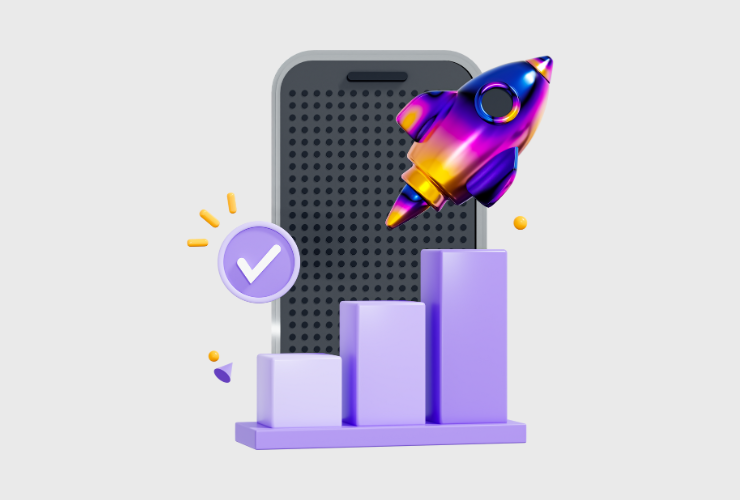
After uploading, preview your episode to ensure everything looks and sounds as intended. Also, double-check that your episode metadata is accurate, including episode numbers, titles, and descriptions.
Listen to a portion of the episode to verify audio quality and make any last-minute adjustments if needed. Once you’re satisfied with the final preview, hit the publish button.
Besides, you can promote your podcast on various channels to attract listeners. So, share your podcast on social media, your website, or through email newsletters. Consider collaborating with other podcasters or reaching out to potential guests for cross-promotion.
Finally, enjoy the process of sharing your knowledge, stories, or insights with the world.
3+ Best Recommended Podcasting Platforms
Now that you understand the process of creating your podcast, let’s explore the best podcasting platforms.
Choosing the right platform is crucial for hosting, distributing, and managing your podcast effectively. Whether you’re a beginner or an experienced podcaster, understanding the various options will help you make an informed decision.
Let’s dive into it!
1. Spotify
Spotify offers a massive audience base, with millions of active users worldwide. So, your content can reach a diverse audience, increasing your chances of attracting new listeners and following.

Besides, for podcasters, it features personalized recommendations and discovery algorithms. Spotify’s algorithm analyzes listener preferences, habits, and genres to provide tailored podcast recommendations. Hence, your podcast has a higher chance of being suggested to users who are interested in your niche.
Key Features of Spotify:
- It provides you with detailed insights, including demographic information, listening trends, and engagement metrics.
- Also helps in understanding your audience and tailoring your content.
- The platform has been actively investing in podcasting, securing exclusive content, and partnering with influential podcast creators.
- You’ll have an opportunity to explore potential collaborations or even secure exclusive distribution deals.
- Spotify allows for seamless integration between music and podcasts.
Pricing:
You can easily sign up to Spotify for free using your Email ID. Or you can always upgrade to the premium version. It comes with 4 paid pricing options.
- Individual Plan: Costs $2.99 per month for a single account. With this plan, you’ll get Ad-free music listening, play anywhere even offline, and on-demand playback.
- Duo Plan: Costs $3.99 per month for 2 accounts. You’ll get Ad-free music listening, play offline, and on-demand playback.
- Family Plan: Costs $4.99 per month for 6 premium accounts. It comes with block explicit music, Ad-free music listening, play offline, and on-demand playback.
- Student Plan: Costs $1.49 per month with special discounts for eligible students in the university. It has Ad-free music listening, plays offline, and on-demand playback.
2. Apple Podcasts
Get ready to explore the iconic Apple Podcasts platform, where millions of shows and more ways to listen await you. It’s available on Apple devices and offers a range of unique features that make it a must-consider platform for podcasters.
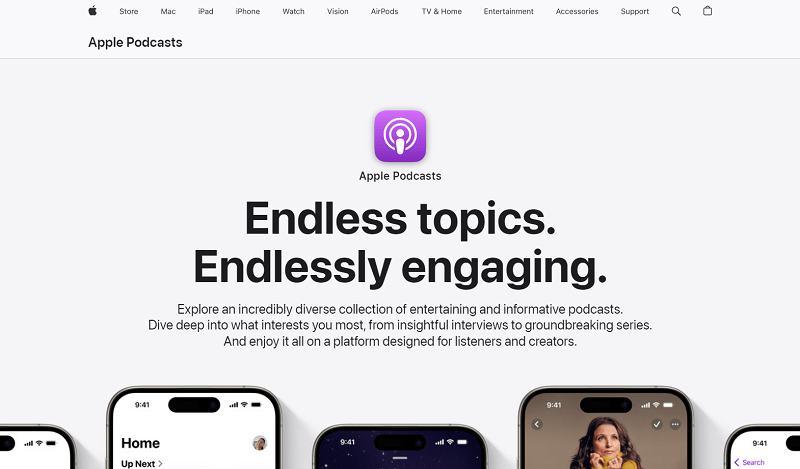
Besides, it provides robust podcast management and discovery features. As a podcaster, you have access to user-friendly tools that allow you to submit and manage your podcast directly on the platform.
In addition, you can customize your podcast’s artwork, description, and metadata, ensuring that your show is accurately represented and stands out in search results.
Key Features:
- It covers a wide range of topics and genres like true crime, comedy, business, or personal development.
- You’ll have the opportunity to discover new shows and explore different perspectives on various subjects.
- Also offers seamless integration with Apple devices like iPhone, iPad, or Mac, making it effortless to access and enjoy podcasts.
- Your podcast will gain visibility and attract new listeners who are actively seeking quality content in their preferred genres.
- You can divide your episodes into sections, making it easier for listeners to navigate and find specific segments of interest.
- Also, episode notes allow you to provide additional context, resources, or references related to your episode.
Pricing:
Setting up your podcast is free. Simply, create an Apple ID if you don’t have one, sign in to Podcasts Connect, and submit your show. Fill in the necessary details, such as the show’s title, description, and artwork.
While Apple Podcasts itself doesn’t charge any fees, it’s important to consider expenses like recording equipment, hosting services, and marketing efforts.
3. YouTube
YouTube is a platform that offers incredible opportunities for podcasters to reach a vast audience and engage with listeners. It’s known for its video content and features that can take your podcasting experience to the next level.
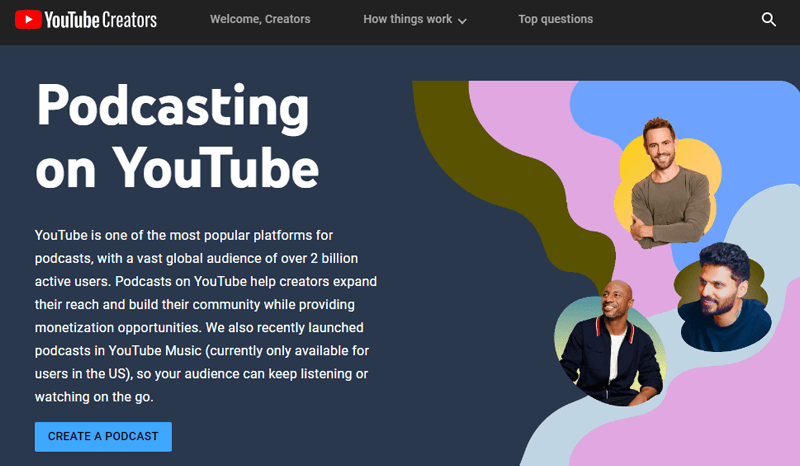
Moreover, it allows you to create video podcasts, where you can complement your audio content with visuals. Also, by adding a visual element to your podcast, you can capture viewers’ attention and convey information visually.
Key Features:
- It provides features like likes, comments, and shares, allowing you to engage with your audience directly.
- Offers various monetization options, like ads, channel memberships, and merchandise shelf integration.
- Also, its live streaming feature allows you to host live podcast episodes, Q&A sessions, or interviews.
- Provides robust analytics that offers detailed insights into your audience demographics, engagement metrics, and viewership trends.
- YouTube is a search engine, and optimizing your video podcast with relevant keywords, tags, and titles can improve your discoverability.
- Collaborate on videos or participate in podcasts hosted by popular YouTubers.
Pricing:
YouTube is free to upload your podcast. You can create a YouTube channel and start uploading your podcast episodes without any cost.
4. Blubrry Podcasting
Blubrry Podcasting is a comprehensive podcast hosting platform that offers a range of features to simplify the podcasting process. With its user-friendly publishing platform and valuable analytics, it provides an all-in-one solution for hosting and managing your podcast.
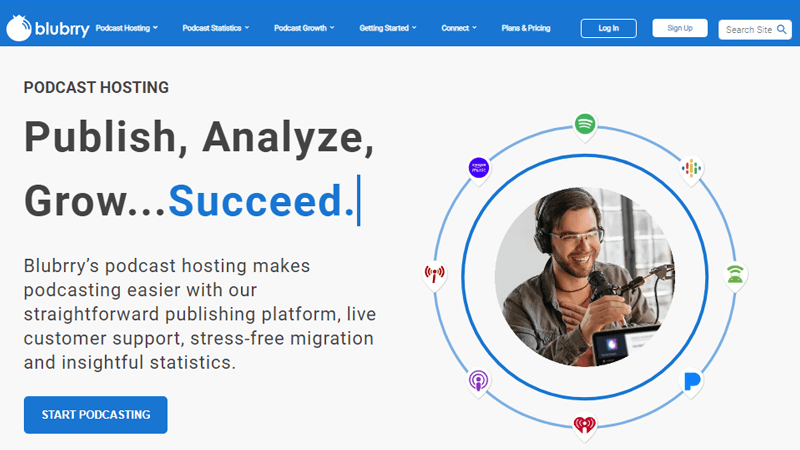
Furthermore, it offers a PowerPress plugin, specifically designed for WordPress users. By integrating PowerPress with Blubrry hosting, you can effortlessly power your podcast directly from your WordPress website.
Besides, if you don’t have a website, then it offers a free WordPress website for all hosting customers. This means you can have a professional online presence without the hassle of creating a website.
Key Features:
- Blubrry’s robust analytics and podcast statistics feature provides valuable insights into your audience.
- With audience surveys, gather demographic information directly from your listeners.
- Additionally, its dynamic ad insertion and programmatic ads capabilities enable you to manage advertising and promotion campaigns.
- You can also take advantage of the media kit feature to create a professional and up-to-date podcast media kit.
- Blubrry’s QuickLinks feature allows you to efficiently manage all your podcast-related links.
- Also provides pro-production services where experienced podcast professionals guide you through the launch, publishing, and social promotion.
Pricing:
It’s a premium podcasting platform that comes in 3 pricing plans from its official website.
- Standard Hosting: Costs $12 per month with 125 MB of new storage every month. You’ll get standard statistics, unlimited downloads and listens, custom embeds players, etc.
- Advanced Hosting: Costs $20 per month starting at 400 MB of new storage every month. It comes with extra available storage, advanced statistics, and more.
- Professional Hosting: Costs $100 per month perfect for businesses, commercial entities, educational institutions, etc. You’ll get unlimited storage, 1 TB bandwidth, etc.
Must-Listen Podcasts: Popular and Engaging
Now that you have learned about different podcasting platforms and their features, let’s explore some popular podcasts. These podcasts cover a diverse range of topics, from true crime and investigative journalism to comedy, self-improvement, and storytelling.
So, let’s dive into it!
1. The Joe Rogan Experience
The Joe Rogan Experience is a wildly popular podcast hosted by comedian and UFC commentator Joe Rogan. This podcast has gained a massive following and has become a cultural phenomenon.
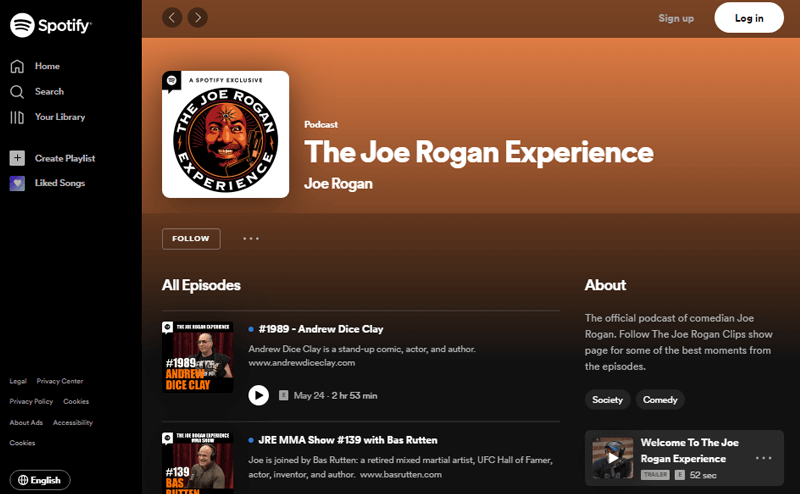
In each episode, Joe Rogan engages in candid conversations with a variety of guests. For example, scientists, comedians, actors, authors, and experts from various fields.
Besides, you can expect engaging dialogues that touch upon social issues, personal experiences, and health and wellness. The podcast’s eclectic mix of topics ensures there’s something for everyone, making it a favorite among millions of fans worldwide.
2. The Daily
The Daily is a highly acclaimed podcast produced by The New York Times. It’s hosted by Michael Barbaro, this podcast delivers in-depth news analysis and storytelling. Therefore, providing listeners with a daily dose of important stories and insightful journalism.
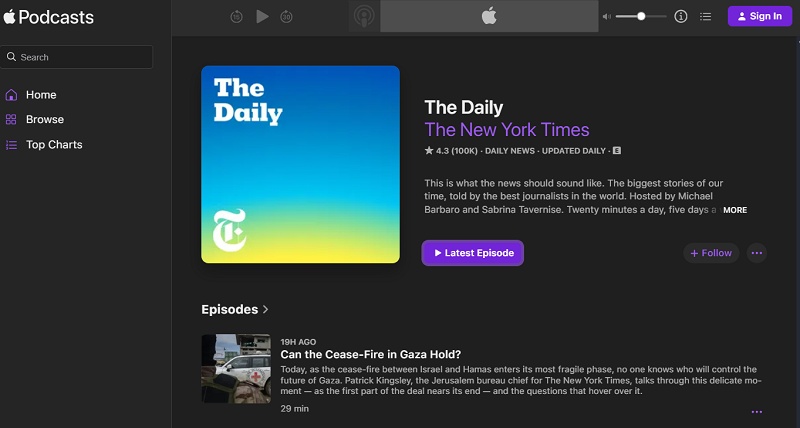
Furthermore, each episode of The Daily focuses on a specific news story or topic. Offering a deep dive into the issues that matter most. Also, it covers a wide range of subjects, including politics, international affairs, social issues, climate change, technology, and more.
Moreover, you’ll get podcasts from investigations into political scandals and coverage of major global events. The podcast’s immersive storytelling style and rigorous journalistic approach captivate listeners. And making it a trusted source for staying informed.
3. This American Life
This American Life is an iconic and influential podcast that has captivated audiences for over two decades. Hosted by Ira Glass, the podcast presents compelling and thought-provoking stories that explore various aspects of American life.
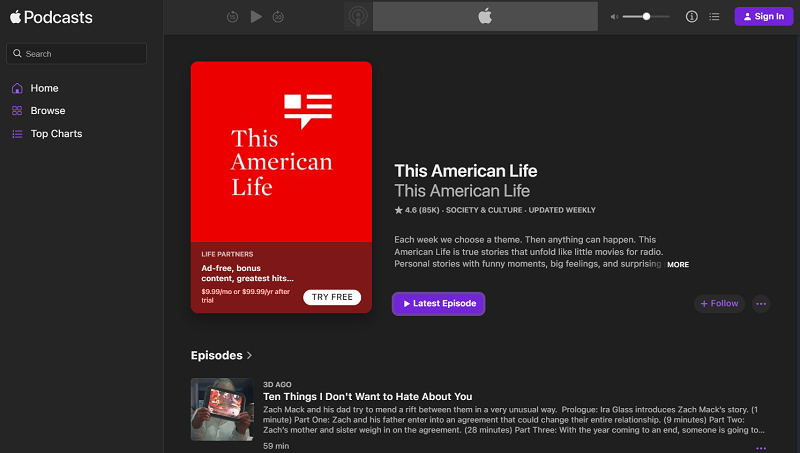
From heartwarming tales of everyday people to investigative journalism it uncovers hidden truths. This American Life tackles diverse subjects in a compelling and empathetic manner.
The podcast explores the complexities of American society. By highlighting the personal narratives of individuals, it offers a unique perspective on the diverse American culture.
4. The Ben Shapiro Show
The Ben Shapiro Show is a popular and influential podcast hosted by Ben Shapiro. With his sharp wit and analysis, he talks about current events, politics, and cultural issues. Also, the podcast has become a go-to platform for those seeking thought-provoking discussions.
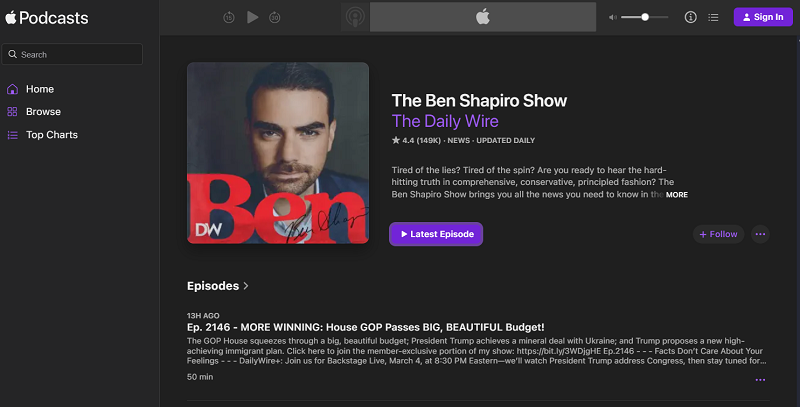
Additionally, this podcast covers a broad spectrum of issues, like policy decisions and analyzing cultural trends. Also, it talks about mainstream narratives and promotes conservative values. Moreover, Shapiro’s engaging style and ability to articulate his viewpoints make this podcast a go-to source for conservative listeners.
Frequently Asked Questions (FAQs)
1. Are podcast audio only?
No, there are video podcasts on several platforms. Podcasts are primarily audio-based shows featuring conversations, interviews, stories, or monologues. You can listen to them on platforms like Apple Podcasts or Spotify on your preferred devices.
2. Do podcasts make money?
Yes, podcasts can generate revenue through various means. By partnering with advertisers, podcasters can earn money through sponsorships and ad placements within their episodes. Additionally, you can offer premium content or exclusive access to subscribers.
3. How long should a podcast be?
The ideal length for a podcast varies depending on your content and audience. It’s important to find a balance between engaging your listeners and respecting their time. Generally, podcasts range from 15 minutes to an hour, but some successful shows can be shorter or longer.
4. Can you podcast alone?
Yes, you can podcast alone. Many podcasters successfully create and host shows as solo endeavors. Also, this allows you to have full control over the content, format, and direction of your podcast.
5. What topics are popular on podcasts?
Podcasts cover a wide range of topics to cater to diverse interests. However, popular podcast genres include true crime, comedy, news, and current events. Additionally, niche topics like history, science, storytelling, and interviews have gained significant popularity.
Conclusion
That’s all! We’re at the end of this article on what is a podcast. We hope this article helped you to understand the key elements of how a podcast works.
Please feel free to comment below if you’ve any further queries about the podcast. We’ll do our best to respond as soon as we can.
Also, let us know how you’re going to start your podcast. You can share your top favorite ideas in the comments section below.
Besides that, we’d also love to hear your thoughts on this article. So, please feel free to comment on any queries or suggestions below.
You may also check our other article on the best CDN providers for video streaming and the best WordPress theme for live streaming.
If you like this article, then please share it with your friends and colleagues. Also, don’t forget to follow us on Twitter and Facebook.

